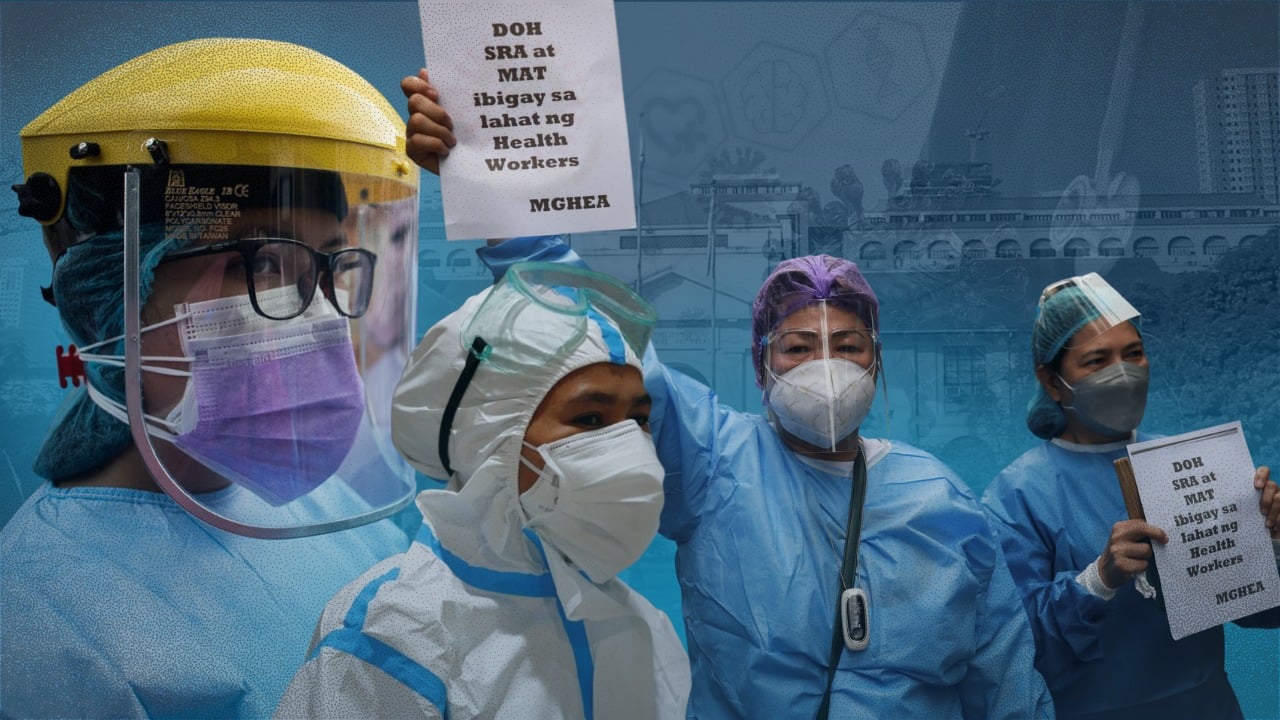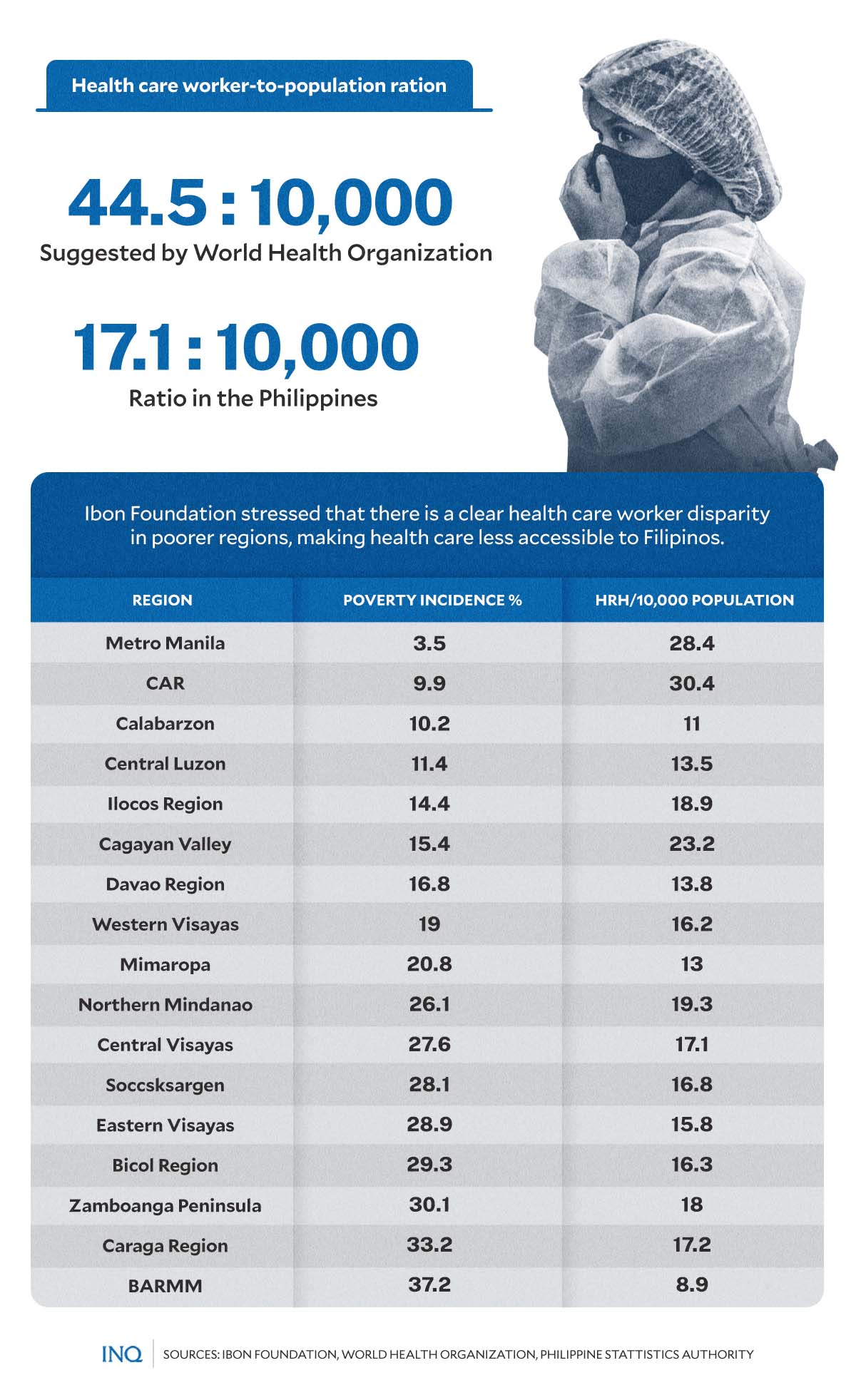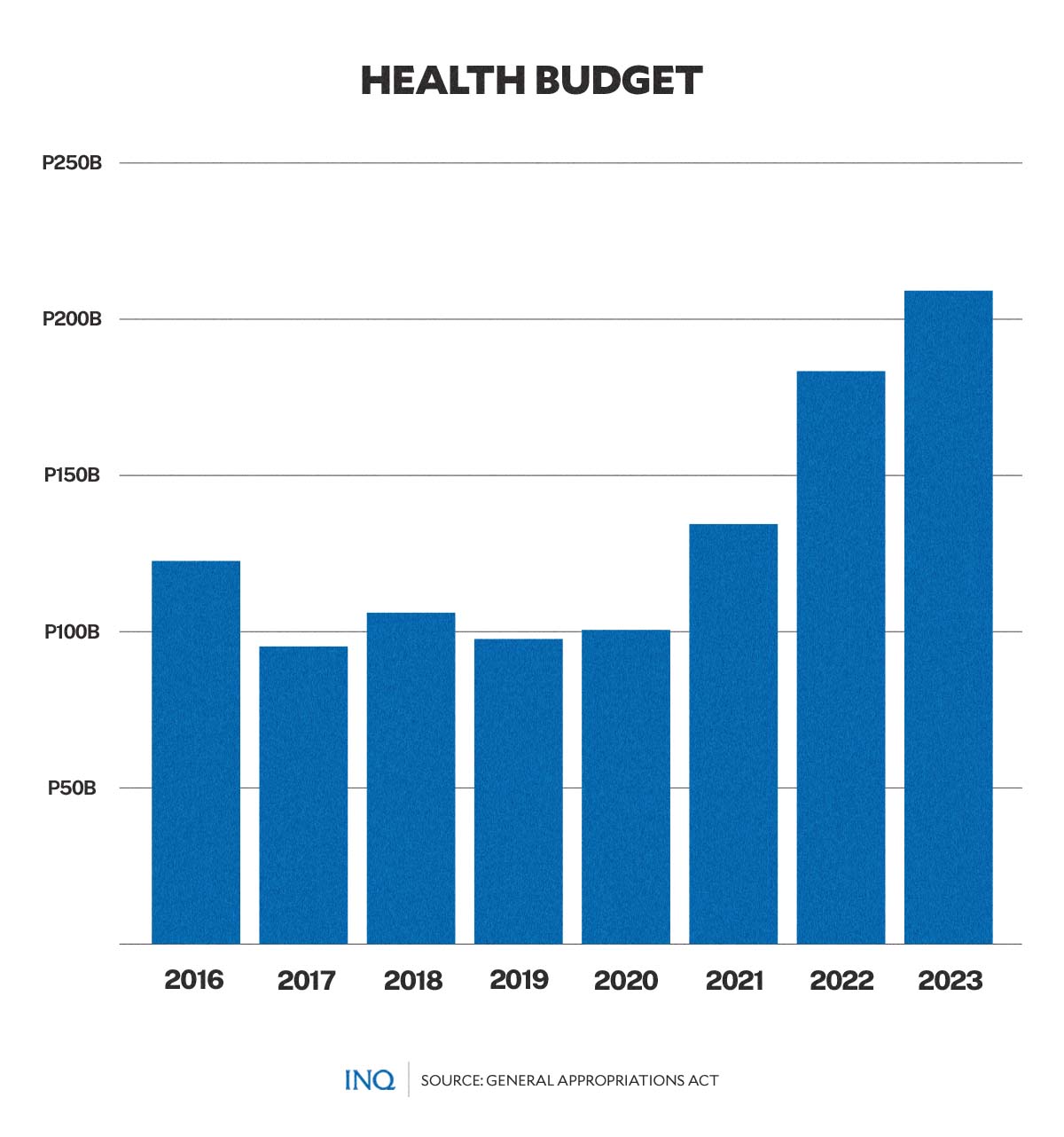PH health care conundrum: Fewer health professionals where people are poorest
MANILA, Philippines—“Lacking,” the health care worker distribution in 2021 in the Philippines did not meet the standard set by the World Health Organization (WHO) to attain Sustainable Development Goals.
This was revealed by Ibon Foundation on Wednesday (April 19) as it stressed that the ratio of 17.1 health care workers for every 10,000 people in the country is not enough, compared to the recommended 44.5.
But while the lack is already disheartening, the think tank said the health care worker disparity is clearer in poorer regions, “making health care less accessible to Filipinos who may need it more.”
As Sonny Africa, executive director of the Ibon Foundation, told INQUIRER.net, “the link between the social determinants of health, such as poverty, and health outcomes is well-established.”
“The poorest regions have the greatest health needs but ironically the most underdeveloped health services. This inequity exacerbates the already huge differences in health outcomes due to the huge gaps in income and wealth,” he said.
Based on government data compiled by the think tank, there were only 8.9 health care workers for every 10,000 people in the Bangsamoro Autonomous Region in Muslim Mindanao even if it had the highest poverty incidence in 2021 — 37.2 percent.
Then in Caraga Region and Zamboanga Peninsula, where poverty incidence is also high at 33.2 percent and 30.1 percent, there were only 17.2 and 18 health care workers for every 10,000 people.
READ: PH poverty: You’re not poor if you spend more than P18.62 per meal
Africa stressed on Monday (April 24) that “the government could go far in bridging the health gap by expanding the public health care system with a bias towards the poorest and neediest regions.”
“However, on the contrary, the health privatization thrust worsens inequity by biasing the health care system towards higher income regions. Health care should be provided according to need and not mainly on the basis of who can afford this,” he said.
Based on the same data, Metro Manila and Cordillera Administrative Region, where poverty incidence is only 3.5 percent and 9.9 percent, had 28.4 and 30.4 health care workers for every 10,000 people.
Then in Calabarzon and Central Luzon, which are the regions closest to Metro Manila, there were 11 and 13.5 health care workers for every 10,000 people. The poverty incidence in these regions was 10.2 percent and 11.4 percent.
‘Maldistribution’
According to Jocelyn Andamo, secretary general of the group Filipino Nurses United, the data presented by the Ibon Foundation “is reflective of reality,” where the health care system “has never been the priority of the government.”
Then for the Health Alliance for Democracy (HAD), the data is indicative of the “maldistribution” of health care facilities, which means that since most facilities are concentrated in city centers, health professionals are in these areas, too.
The group told INQUIRER.net that local government units (LGUs) in poorer regions “may not have enough resources or do not prioritize the hiring of enough health care workers, a result of the devolution of health care services.”
HAD said health care workers choose not to work in poorer regions, where income and benefits are lower than in city centers since “the Salary Standardization Law allows poorer LGUs to provide salaries that are below the national rate.”
As Africa said, “the amount of budgetary resources given to public health care is a political choice, [wherein] the government can give as much priority to health in the national budget as it wants to.”
“But unfortunately, it is spending as little on the health care system as it can get away with,” he said.
Based on data from the Department of Budget and Management, the Department of Health had a budget of P122.63 billion in 2016, P95.27 billion in 2017, P106.08 billion in 2018, P97.65 billion in 2019, P100.56 billion in 2020, and P134.45 billion in 2021.
READ: P296.3-B health budget for 2023: Higher but still ‘not enough’
Last year, it had P183.37 billion, then P209.13 billion this year.
“The largest chunk of health spending is on Philippine Health Insurance Corp., which means that a disproportionate portion of health spending is going to profit-driven private health care,” Africa said.
Health care workers neglected
Andamo told INQUIRER.net that the health care system in the Philippines should be responsive and relevant, “but it is not,” especially because the economic and social needs of health care workers are not prioritized.
“If you lack health care workers, you will lack in your response to people’s health needs, but in the Philippines, the needs of health care workers are not addressed so they are not content, their rights are not respected, and their dignity as workers is stripped,” Andamo said.
“So as a result, they decide to leave the health care system,” she said, stressing the problem in recruitment and retention. “How can you encourage graduates to apply and those already in the health care system to stay on?”
READ: Nurses’ exodus: Choice obvious between better future abroad, shabby treatment at home
Based on 2020 data from the Philippine Overseas Employment Administration, which was cited in a University of the Philippines report on human resource for health, there is an out migration of 13,000 health care professionals every year.
HAD said “the government has long neglected the welfare and protection of health workers. Inadequate salaries and benefits, lack of protection, inadequate health facilities, supplies and medicines force many to seek better paying jobs abroad.”
“There are not enough plantilla positions for health care workers […] Yet DOH and LGUs are hiring thousands of contractual health care workers through Nurse Deployment Program and similar contractual programs,” said the group.
It also stressed that the government in so many ways encourages labor export of health care workers, while education of medical students prepares them to work overseas, not to serve in the country and in poorer regions where they are needed most.
RELATED STORY: Nurses start countdown to 10-day deadline for their benefits
“Even the practice of professions are geared towards making our health care workers more ‘marketable’ and to have better credentials to work abroad,” HAD said on Monday (April 24).
Then add to these the “failure of the government to protect health care workers.”
“Many health workers’ lives were needlessly lost during the COVID-19 pandemic with lack of personal protective equipment, test kits, transportation and other logistical support,” HAD said.
“Those few health workers who remained to serve our countrymen are red-tagged and killed, as in the case of slain Dr. Mary Rose Sancelan, the lone doctor in Guihulngan, Negros Oriental and head of COVID-19 response team in the area.”
Less access to health care
Andamo said when there are fewer health care workers in poorer regions because the health care system itself is not responsive and relevant to people’s health needs, there will be “more sickness, more deaths.”
READ: Preventable: 60,000 PH children die per year before 5th birthday
Why? “It is because sickness and deaths are not being prevented by the health care system, which is lacking in resources.”
HAD said poorer people in poorer regions suffer more from inadequate health care workers and inadequate health services: “Less health care workers means less services.”
“This will result in more illness, especially among the poor majority, and worsening of the health situation in the Philippines,” the group said.
“If the government is really sincere in improving the health of the people, it should prioritize health – not only health infrastructure, but most importantly access of the poor majority to free and comprehensive health care,” it said.
This includes ensuring and retaining adequate health care workers to serve the Filipino people, HAD said.
RELATED STORY: Health care workers’ benefits: ‘Singular’ plan brings multiple issues


